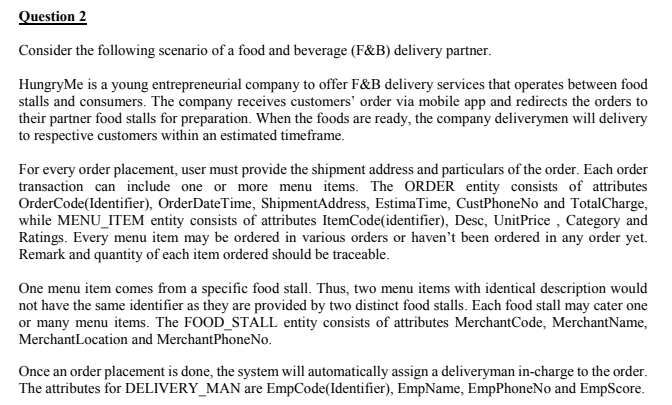ibutes). Resolve many-to-many relationships, if any. Make common business rule assumption if necessary. b) For each of the entities in the ERD drawn in Question 2 a), list all relevant attributes using Database Design Language (DBDL) format. In your listing, show all the primary keys, composite keys and foreign keys (if any) clearly. Underline all the primary keys or composite keys and identify the foreign key with an
ibutes). Resolve many-to-many relationships, if any. Make common business rule assumption if necessary. b) For each of the entities in the ERD drawn in Question 2 a), list all relevant attributes using Database Design Language (DBDL) format. In your listing, show all the primary keys, composite keys and foreign keys (if any) clearly. Underline all the primary keys or composite keys and identify the foreign key with an
Computer Networking: A Top-Down Approach (7th Edition)
7th Edition
ISBN:9780133594140
Author:James Kurose, Keith Ross
Publisher:James Kurose, Keith Ross
Chapter1: Computer Networks And The Internet
Section: Chapter Questions
Problem R1RQ: What is the difference between a host and an end system? List several different types of end...
Related questions
Question
a) Draw an Entity-Relationship Diagram (ERD) for the above scenario using the Crow’s Foot notation (exclude all attributes). Resolve many-to-many relationships, if any. Make common business rule assumption if necessary.
b) For each of the entities in the ERD drawn in Question 2 a), list all relevant attributes using
key with an *.

Transcribed Image Text:Question 2
Consider the following scenario of a food and beverage (F&B) delivery partner.
HungryMe is a young entrepreneurial company to offer F&B delivery services that operates between food
stalls and consumers. The company receives customers' order via mobile app and redirects the orders to
their partner food stalls for preparation. When the foods are ready, the company deliverymen will delivery
to respective customers within an estimated timeframe.
For every order placement, user must provide the shipment address and particulars of the order. Each order
transaction can include one or more menu items. The ORDER entity consists of attributes
OrderCode(Identifier), OrderDateTime, ShipmentAddress, EstimaTime, CustPhoneNo and TotalCharge,
while MENU_ITEM entity consists of attributes ItemCode(identifier), Desc, UnitPrice , Category and
Ratings. Every menu item may be ordered in various orders or haven't been ordered in any order yet.
Remark and quantity of each item ordered should be traceable.
One menu item comes from a specific food stall. Thus, two menu items with identical description would
not have the same identifier as they are provided by two distinct food stalls. Each food stall may cater one
or many menu items. The FOOD_STALL entity consists of attributes MerchantCode, MerchantName,
MerchantLocation and MerchantPhoneNo.
Once an order placement is done, the system will automatically assign a deliveryman in-charge to the order.
The attributes for DELIVERY_MAN are EmpCode(Identifier), EmpName, EmpPhoneNo and EmpScore.
Expert Solution
This question has been solved!
Explore an expertly crafted, step-by-step solution for a thorough understanding of key concepts.
Step by step
Solved in 3 steps with 1 images

Recommended textbooks for you

Computer Networking: A Top-Down Approach (7th Edi…
Computer Engineering
ISBN:
9780133594140
Author:
James Kurose, Keith Ross
Publisher:
PEARSON

Computer Organization and Design MIPS Edition, Fi…
Computer Engineering
ISBN:
9780124077263
Author:
David A. Patterson, John L. Hennessy
Publisher:
Elsevier Science

Network+ Guide to Networks (MindTap Course List)
Computer Engineering
ISBN:
9781337569330
Author:
Jill West, Tamara Dean, Jean Andrews
Publisher:
Cengage Learning

Computer Networking: A Top-Down Approach (7th Edi…
Computer Engineering
ISBN:
9780133594140
Author:
James Kurose, Keith Ross
Publisher:
PEARSON

Computer Organization and Design MIPS Edition, Fi…
Computer Engineering
ISBN:
9780124077263
Author:
David A. Patterson, John L. Hennessy
Publisher:
Elsevier Science

Network+ Guide to Networks (MindTap Course List)
Computer Engineering
ISBN:
9781337569330
Author:
Jill West, Tamara Dean, Jean Andrews
Publisher:
Cengage Learning

Concepts of Database Management
Computer Engineering
ISBN:
9781337093422
Author:
Joy L. Starks, Philip J. Pratt, Mary Z. Last
Publisher:
Cengage Learning

Prelude to Programming
Computer Engineering
ISBN:
9780133750423
Author:
VENIT, Stewart
Publisher:
Pearson Education

Sc Business Data Communications and Networking, T…
Computer Engineering
ISBN:
9781119368830
Author:
FITZGERALD
Publisher:
WILEY